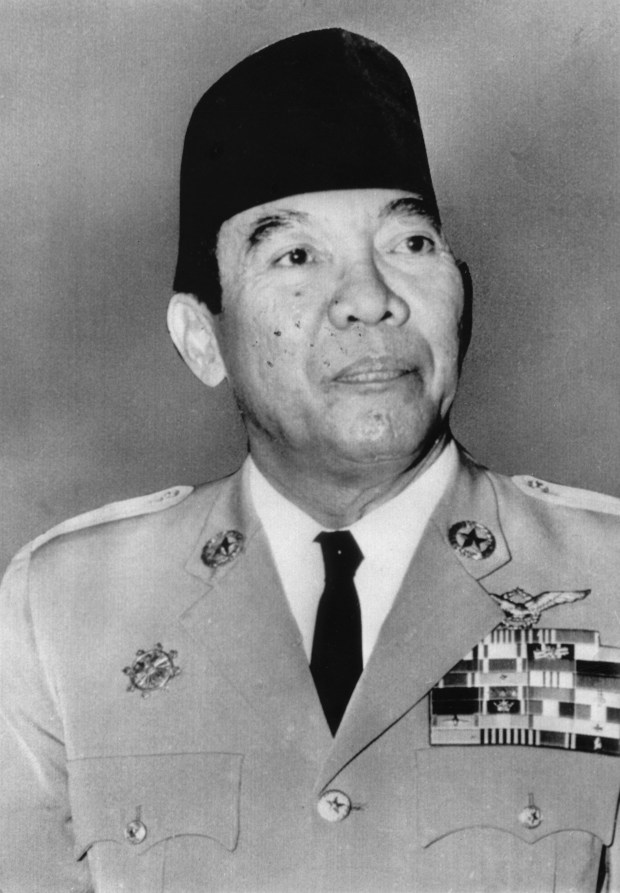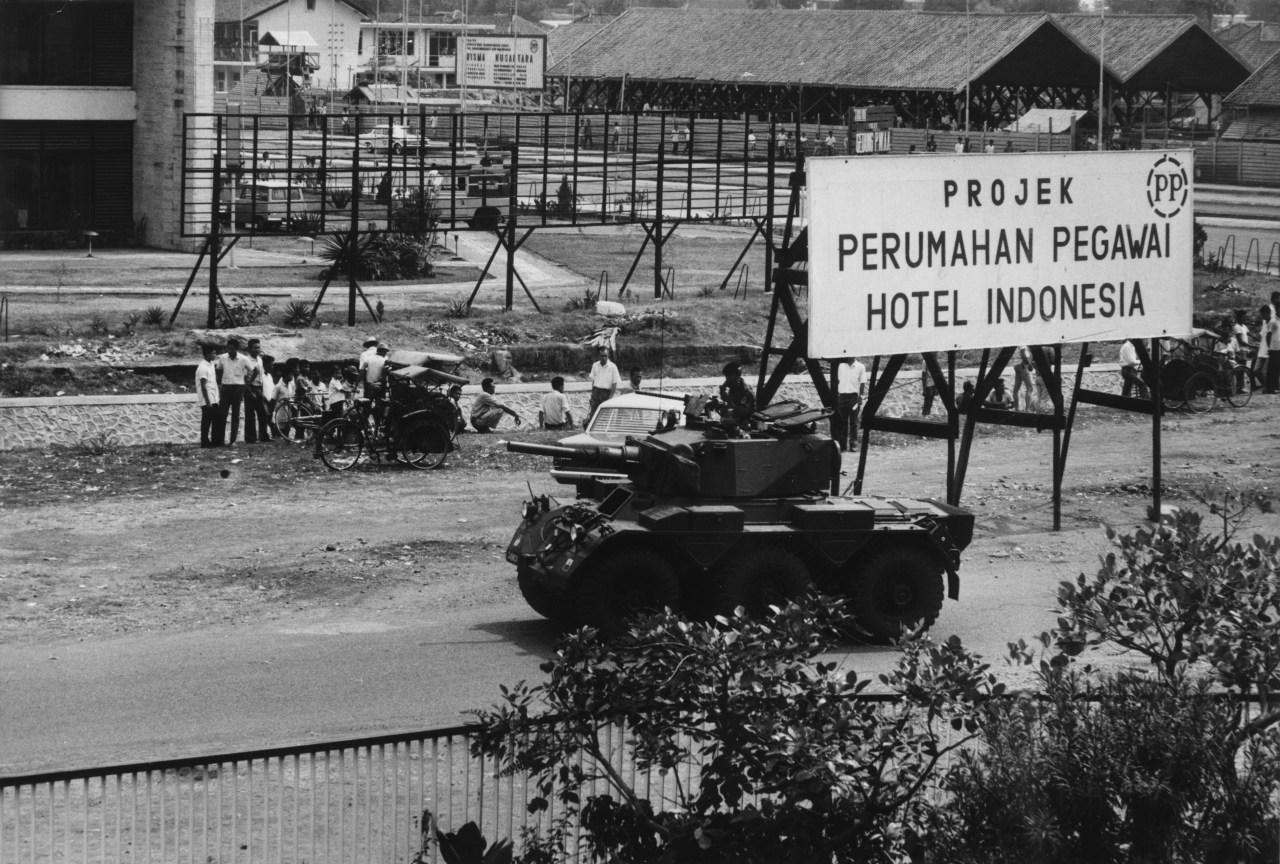Indonesia, the world’s fourth-most-populous country, is an archipelago of some 17,000 islands, inhabited by hundreds of ethnic groups that could have easily splintered into several different countries after centuries of Dutch colonial rule.
Less than a decade after finally expelling the Dutch in 1949, a series of rebellions did threaten to break the young nation apart, and the United States—more specifically, the Central Intelligence Agency—fought with them against the government of President Sukarno. Washington’s problem was not the unity of the Indonesian people, who had been brought together by the charismatic nationalist who mixed aspects of Marxism, anticolonialism, and Islam, espoused “unity in diversity,” and adopted Bahasa Indonesia as the country’s official language. The issue was that Sukarno was too left wing for Washington’s liking and refused to explicitly align with the United States.
The attempt to weaken him by supporting regional rebellions ended in tragic, absurd failure in 1958. But Sukarno did eventually fall, after one of the worst episodes of mass murder in the 20th century, which began seven years later.
“This was not a war,” says Baskara T. Wardaya, a professor at Sanata Dharma University in Yogyakarta. Wardaya, a Catholic priest who is also an expert on the Cold War and Indonesian history, says the mass violence of 1965–6 was a massacre carried out by the state against innocent civilians. “Hundreds of thousands, up to 1 million people, were murdered and the country was left traumatized.”
U.S. documents released last year confirmed that U.S. diplomats in Jakarta knew about the killings and provided information and resources to carry them out.
Sukarno cemented his role as a global anticolonial leader in 1955, when he organized the Asia-Africa Conference in Bandung; it was the first formal attempt to bring together the world’s formerly colonized peoples. Over the following years the Communist Party of Indonesia (PKI) gained influence and members through mass educational, agricultural, and cultural programs. Many in Washington believed that Sukarno, though he was not a Communist and was making sure to include conservative elements in his government, was too tolerant of the PKI.

The CIA discussed the possibility of assassinating him. President Eisenhower ordered the agency to support regional rebellions against the central government in order to weaken or topple Sukarno. The covert support for the rebels was exposed on May 18, 1958, when CIA operative Allen Pope was shot down and captured on the island of Ambon after he conducted air raids that had killed civilians. The regional rebellions failed, and the U.S. shifted its Indonesia strategy from fighting the army directly to supporting and training its soldiers in Kansas. According to the memoirs of Howard Jones, the U.S. ambassador to Indonesia at the time, Sukarno became suspicious of Washington and its Western allies and moved closer to the socialist countries after the CIA intervention.
By 1965 Indonesia had grown closer to the Asian socialist countries, and Sukarno had become more stridently anti-American. The country was two years into a low-intensity armed conflict with neighboring Malaysia, angering the United Kingdom and the United States, and the right-leaning leaders of the armed forces were deeply concerned about the prospect of losing power.
By then tens of millions of people, roughly a quarter of the country, were in the (fully legal) PKI or political organizations associated with the party. With approximately 3.5 million card-carrying members, it was the largest communist party in the world outside the Soviet Union and China.
On Oct. 1, the army got the excuse to crush the Communists that the U.S. had been looking for. A group of apparently left-leaning soldiers, calling themselves the September 30th Movement, kidnapped and killed six high-ranking generals in Jakarta. By some accounts, the soldiers’ plan was to kidnap their superiors and accuse them of organizing a right-wing coup. Some evidence indicates that top PKI leadership knew about or even helped form the soldiers’ plot. To this day, however, it is unknown who really planned the operation, what they hoped to achieve, or if any international actors were involved.
But what happened next is very clear. General Suharto quickly took de facto control of the country, sidelining Sukarno, and shut down all media the Army didn’t control. He announced (falsely) that Communists had participated in a putative coup attempt and had savagely mutilated the generals’ bodies. Western media outlets helped spread the message.

Over the next few months the military, under Suharto, oversaw the mass slaughter of between 500,000 and 1 million people. Almost all of them were civilians and were targeted for their political beliefs, their ethnicity (Chinese Indonesians were also targeted), for belonging to labor unions, or for example, liking music enough to gravitate to the left-wing cultural organization that held concerts in Indonesian villages. Civilian groups, especially conservative Muslim organizations, worked with the army to eliminate leftists and alleged leftists en masse.
Witnesses and perpetrators alike said that soldiers decapitated, strangled, and threw suspected Communists into rivers. According to interviews with survivors carried out by scholars such as Jess Melvin, some members of the PKI turned themselves in to authorities, thinking they’d be safe in military hands, only to be executed. Another million Indonesians were herded into brutal concentration camps for a decade or more.
Officials in the U.S. government supplied the perpetrators with communications equipment, weapons, and lists of names of alleged Communists.
“It really was a big help to the army,” Robert J. Martens, a former member of the U.S. embassy’s political section, told the Washington Post in 1990. “They probably killed a lot of people, and I probably have a lot of blood on my hands, but that’s not all bad.”
The work of Bradley Simpson at the National Security Archive in Washington, D.C., has demonstrated that as the violence unfolded, the army understood that aid and support from the U.S. was dependent on the PKI being “crushed” and Sukarno being removed. Recently declassified documents confirm that U.S. officials received detailed updates on the killings and offered help to suppress negative coverage.
Sukarno’s base of support was shattered by the violence, and General Suharto took over with the enthusiastic backing of the U.S. government and business community. Suharto ruled Indonesia for more than 30 years, making fanatical anticommunism and record-breaking levels of corruption cornerstones of his regime.
In 1975 he oversaw a military invasion of East Timor, which had recently declared independence from Portugal, that killed roughly a third of the population.
The history books offered to Indonesian students under Suharto reproduced the myth that led to the massacre, and its perpetrators ran the country. The government produced a crude propaganda film, Pengkhianatan G30s/PKI, which aired on state television each year on the anniversary of the alleged coup attempt by the Communists. Indonesia remained united, but instead of staying together under Sukarno’s more inclusive vision, national identity was based on the violent exclusion of the left. The survivors of the Communist purges were social outcasts.

Since the fall of Suharto’s dictatorship in 1998, human rights groups and educators have attempted to correct that history; but they have come up against the power of the military and resurgent Islamic conservatism.
In 2004 a team of academics presented a plan to the Ministry of Education to include mention of the purges in the national curriculum and remove the spurious claim that the PKI masterminded a coup attempt that led to the violence. But under pressure from conservative religious groups, the project was abandoned. “We came to the conclusion that it is too difficult for the students to understand the complexity of the political situation at the time,” says Djoko Suryo, a professor at Gadjah Mada University, who was part of the effort.
But the release in 2012 of The Act of Killing, a documentary in which the murderers brag about and proudly reenact their crimes, and the follow-up film, The Look of Silence, reignited interest in the topic within and outside Indonesia. In 2015 the International People’s Tribunal in The Hague found that Indonesian authorities in 1965–6 were guilty of genocide and widespread crimes against humanity. The government of current President Joko “Jokowi” Widodo, however, has resisted calls from human rights groups to apologize for the massacres and initiate a truth and reconciliation process, perhaps because the president is battling attacks from more conservative sectors as he seeks reelection early next year.
Many survivors of the violence live in poverty and hide their past. But all across Indonesia there are countless people, still suffering the serious trauma, who will tell their stories to those they think they can trust.
“I never thought I was doing anything wrong or anti-Indonesian just because I was working for a Communist. I was working for him because he was the mayor,” one survivor, who asked not to be identified, told me this month. He was referring to the mayor of Solo, where he had a low-level job at City Hall in 1965. He was beaten, starved, and imprisoned while many of his neighbors and acquaintances were murdered; when he finally got out, he could not find work. “I was treated like I wasn’t human, like I don’t exist. But we are still alive. We do exist.”
Vincent Bevins is an American journalist based in Jakarta and is currently writing a book on mass violence and Indonesia in the Cold War. Febriana Firdaus is an Indonesian journalist and founder of the Ingat65 (Remember 1965) organization.